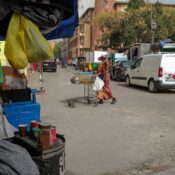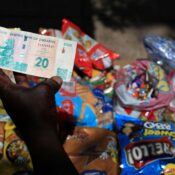
Zimbabwe claims that its currency backed by gold is stable, but investor skepticism endures
The central bank claims that Zimbabwe’s gold-backed currency is stable and has more than 100% reserve cover, but there are still concerns about its legitimacy, which are highlighted by a continuous premium in the parallel market.
The Reserve Bank of Zimbabwe announced total reserves of $701 million on Monday and maintained its benchmark rate at 35%, citing a steady exchange rate as one of the reasons. According to the bank, the percentage of transactions made with Zimbabwe Gold (ZiG) money increased from 26% in April 2024, the month it was introduced, to 43% in May.
The majority of people still make most of their purchases in US dollars due to decades of economic turmoil and currency devaluations. However, the government hopes that Zimbabweans will feel more comfortable using the ZiG for daily transactions because of its gold backing.
“ZiG is our national currency, and as the central bank, we are committed to ensuring its success by maintaining all the fundamental characteristics of sound money, including its function as a reliable store of value,” Reserve Bank Governor John Mushayavanhu wrote in answer to inquiries from Reuters.
“The Reserve Bank has learned from previous currency failures that maintaining optimum money supply and ensuring monetary stability is vital,” he stated.
The difference between the official exchange rate and the parallel market rate is still around 20%, even with the bank’s guarantees.
Black-market trader Pearson Tambudze stated, “The rate has been stable for more than three months,” and he attributed the stability to a shortage of the local currency rather than a return of trust.
“There isn’t a lot of ZiG in the market,” he stated.
While applauding the stability of the ZiG, the IMF is advising Zimbabwe to implement stricter money-growth restrictions, a more open foreign exchange market, and to get closer to paying down an estimated $12.2 billion in external debt.
Last month, Zimbabwe’s finance minister, Mthuli Ncube, said he hoped that prudent monetary policy and currency stability would allow the country to raise $2.6 billion in bridge loan by the middle of 2026.
But investors are still wary.
“At this point, we wouldn’t invest in Zimbabwe. Before we would contemplate it, the nation needs to develop much more,” stated Jetro Siekkinen of LGT Capital Partners.
Concerns were also raised by economists regarding Zimbabwe’s reserve cushion, which is only 0.8 months’ worth of import cover—far less than the IMF’s suggested three-month safety net.
Oxford Economics analyst Lyle Begbie stated, “In terms of priority, I would consider the clearance of arrears with multilateral creditors to be most important.”
Begbie projected that future initiatives will have a similar fate to two previous IMF staff-monitored programs that failed within 15 months.
“Ultimately, we are likely years away from the IMF providing concessional financing to Zimbabwe, even if the country does everything right, which itself is not likely,” he stated.
All Categories
Tags
+13162306000
zoneyetu@yahoo.com


